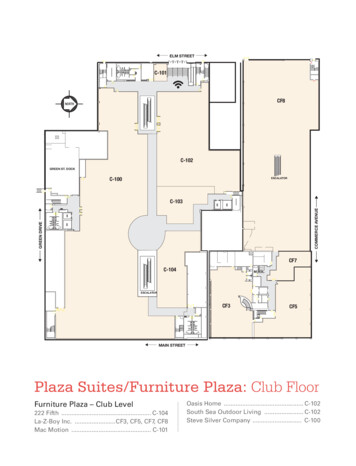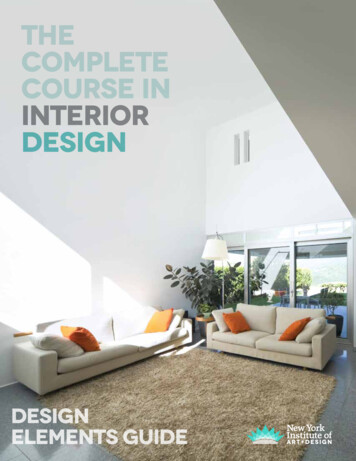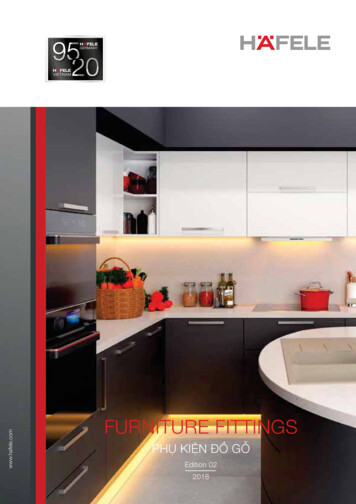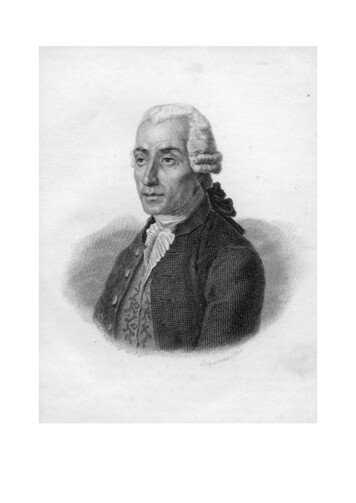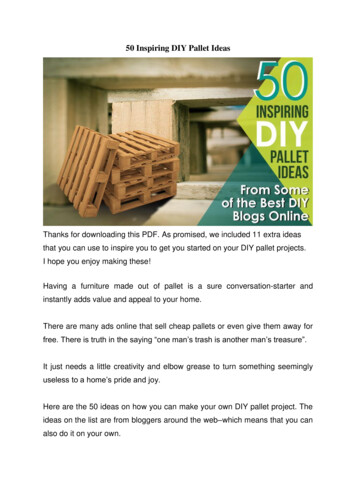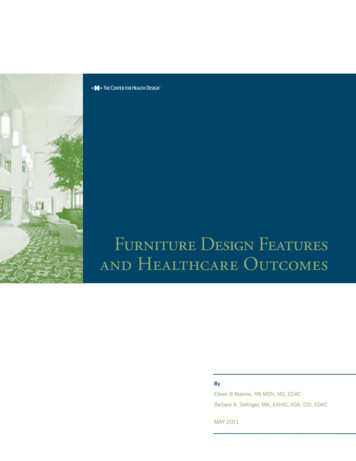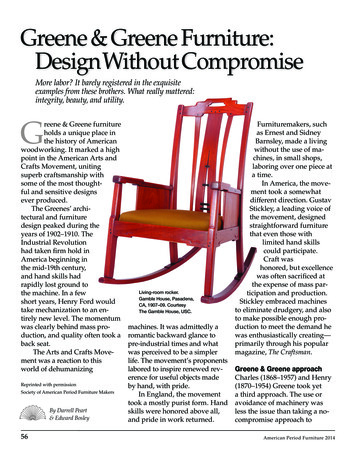
Transcription
Greene & Greene Furniture:Design Without CompromiseMore labor? It barely registered in the exquisiteexamples from these brothers. What really mattered:integrity, beauty, and utility.Greene & Greene furnitureholds a unique place inthe history of Americanwoodworking. It marked a highpoint in the American Arts andCrafts Movement, unitingsuperb craftsmanship withsome of the most thoughtful and sensitive designsever produced.The Greenes’ architectural and furnituredesign peaked during theyears of 1902–1910. TheIndustrial Revolutionhad taken firm hold inAmerica beginning inthe mid-19th century,and hand skills hadrapidly lost ground tothe machine. In a fewshort years, Henry Ford wouldtake mechanization to an entirely new level. The momentumwas clearly behind mass production, and quality often took aback seat.The Arts and Crafts Movement was a reaction to thisworld of dehumanizingReprinted with permissionSociety of American Period Furniture MakersBy Darrell Peart& Edward Bosley56Living-room rocker.Gamble House, Pasadena,CA, 1907–09. CourtesyThe Gamble House, USC.machines. It was admittedly aromantic backward glance topre-industrial times and whatwas perceived to be a simplerlife. The movement’s proponentslabored to inspire renewed reverence for useful objects madeby hand, with pride.In England, the movementtook a mostly purist form. Handskills were honored above all,and pride in work returned.Furnituremakers, suchas Ernest and SidneyBarnsley, made a livingwithout the use of machines, in small shops,laboring over one piece ata time.In America, the movement took a somewhatdifferent direction. GustavStickley, a leading voice ofthe movement, designedstraightforward furniturethat even those withlimited hand skillscould participate.Craft washonored, but excellencewas often sacrificed atthe expense of mass participation and production.Stickley embraced machinesto eliminate drudgery, and alsoto make possible enough production to meet the demand hewas enthusiastically creating—primarily through his popularmagazine, The Craftsman.Greene & Greene approachCharles (1868–1957) and Henry(1870–1954) Greene took yeta third approach. The use oravoidance of machinery wasless the issue than taking a nocompromise approach toAmerican Period Furniture 2014
design. Whatever the designrequired was built, machineor no machine. The integrity,beauty, and utility of the finished piece of furniture werewhat mattered.Unlike Stickley, the Greenes’furniture was not simplified.Nor was it accessible to everyone. It was, in fact, exclusive inall regards. Only the wealthiest of clients could afford theGreene-designed houses andfurniture, and only the most accomplished woodworkers couldbuild to their specifications.As a young man, CharlesGreene dreamed of being an artist. As an architect, he devotedhis creative energy almost exclusively to the designs of housesand furniture. Beauty and usefulness were of supreme importance. Charles Greene called it“architecture as a fine art.”1His younger brother, Henry,expressed it equally well: “Thewhole construction was carefully thought out; there was areason for every detail. The ideawas to eliminate everything unnecessary, to make the whole asdirect and efficient as possible,but always with the beautiful inmind as the final goal.”2The Greenes’ approach didnot go unnoticed. On a visitto America in 1909, CharlesRobert Ashbee, a leading voiceof the English Arts and CraftsMovement, singled out theGreenes’ work as equal to thefinest English craftsmanship:“ [B]eautiful cabinets andchairs of walnut and lignumvitae, exquisite dowelling andpegging, and in all a supremewww.sapfm.orgfeeling for the material, quiteup to the best of our Englishcraftsmanship.”3Vital collaboration withthe Hall brothersIn their early years as a firm, theGreenes were unable to securereliable and skilled craftsmento execute their complex architectural and furniture construction. In 1904, the Greenesbegan collaborating with masterbuilders Peter (1867–1939) andJohn Hall (1864–1940), whoseinterest in structural integrityheld equal status with beauty.The Hall brothers formed a vitalpart of the Greene & Greenefirm in Pasadena, California.Charles Greene studio door carved by Charles.Carmel, CA.The quality of work producedrequired much more than theusual designer/builder relationship. Their deep understandingof each other was absolutelyessential.The Greenes were lifelongwoodworkers. As teenagers,Mirror Frame by John Hall 1909.Courtesy Hall family.they attended Calvin Woodward’s Manual Training Schoolin St. Louis, where their daywas divided evenly between intellectual subjects and draftingor crafts, such as machine-toolmaking and woodworking.Charles Greene did not shyaway wielding tools, and inlater years practiced his carvingskills professionally, as shownat left. Henry also was known totake on woodworking projects.Indeed, it is important to notethat the Greenes had a goodworking knowledge of manualskills before they trained inarchitecture.The Halls, more than mostmakers, learned the finer pointsof design at an early age. Theirfather most likely trained themat home in the Sloyd method,which placed a high value onteaching design and handcraftsas part of a child’s education.Both the Hall brothers designed and built personal projects, but John especially had asolid design sense. Of his surviving projects, a mirror frameabove illustrates his profoundunderstanding of design, as57
1Living-room bookshelves view from above.Thorsen House, Berkeley, CA, 1908–10. Courtesy California Sigma Phi Society.2Living-room bookshelves view from below,with waterfall detail. Thorsen House,Berkeley, CA, 1908–10. Courtesy CaliforniaSigma Phi Society.3Living-room bookcase ebony escutcheon.Thorsen House, Berkeley, CA, 1908–10. Courtesy California Sigma Phi Society.58well as his ability to assimilatethe Greene & Greene approach.Biographers and scholarshave documented a remarkableconnection between CharlesGreene and John Hall. It wassaid that Charles would visitthe Hall shop in Pasadena onhis daily rounds, and wouldengage John on the details ofwhatever piece of furniturewas on the bench. One can onlyspeculate on the nature of theseconversations.Appealing to the sensesFor Charles and Henry Greene,every detail—however subtle—was designed to appeal to thesenses. Nuance flourished inthe name of beauty. Elementsof utility were reimagined, andmade to conform to the Greenestandards as well.The built-in bookcases(Photo 1) of the 1909 ThorsenHouse in Berkeley, California,are a prime example. Mostwoodworkers understand thatbookshelves must be beefy tosupport the considerable weightof books. Most woodworkersunderstand the dilemma in designing heavy-duty bookshelvesthat will sustain the weight oftheir contents without appearingtoo bulky or unattractive in theirdesign. The Greenes turned thiswould-be problem into an aesthetic asset.Viewing the shelf straighton, we see a slender, pleasing profile. Looking on theunderside (Photo 2), we see awaterfall detail that not only isaesthetically pleasing but alsoallows the deeper body of theshelf to gradually become morerobust. This detour—in the service of beauty and function—created considerably morework. But apparently, that wasof little concern to the designers, makers, and clients.Another characteristic ofGreene & Greene design is thattwo elements rarely meet in thesame plane. Consider, for example, the shelf’s breadboardend. It is proud of the panel inevery change of elevation, mostof which is on the seldom-seenbottom side.The use of escutcheons isanother prime example ofbeauty at a cost, as shown inPhoto 3. Rather than relying on off-the-shelf hardware(something the Greenes seldomdid), they delicately carved andinlaid ebony in place of a manufactured metal piece. Again,this treatment represents anenormous amount of additionalwork in the pursuit of beauty.Designs rarely repeatedUnlike many of their contemporaries in the American Arts andCrafts Movement, the Greenesdid not repeat their designs formass production. Each piecewas designed for a specific client and setting. Details oftenwere developed for these settings and never duplicated. Atthe same time, a distinctive continuity of style permeates thedesigns of the Greenes’ matureperiod (1907–12). Individualsettings or rooms, however,were always distinct from oneanother, as shown in the rockers on page 56 and the next page.American Period Furniture 2014
Master-bedroom rocker.Gamble House, Pasadena,CA, 1907–09. CourtesyThe Gamble House, USC.4Dining-room built-in cabinet with delicate cloudlifts. Thorsen House, Berkeley, CA, 1908–10.Courtesy California Sigma Phi Society.This meant dipping intothe well of creativity for freshmaterial for each setting forevery client.The Greenes’ most productive and creative span—particularly regarding furniture—lasted about seven years, from1906 through 1912. It was anintense time for the Greeneswho received roughly 150 commissions for residential dwellings and their furnishings. TheGreenes produced hundredsof individual furniture designs which undoubtedly putan immense strain on CharlesGreene’s creative resources. Infact, he took a seven-month period of rest in England in 1909,leaving Henry to keep projectson track in the office.www.sapfm.orgThe detail inGreene & Greenefurniture and architectural designs canseem overwhelming.Even among detailsthat were repeated, eachinstance of their use wasreimagined with contextin mind. An expedient cutand-paste was not part of theGreenes’ way of working. Forexample, they incorporated ainspired cloud lift (frequentlyseen in Ming Dynasty furniture where it is identified as ahumpback stretcher when soused in chairs) in nearly infinitevariety, depending upon thesetting. Sometimes the patternwould be upside-down, sometimes on-end, and other variations (Photos 4 and 5).Even the sleek ebony pegwas not immune from creativevariation, as shown in Photo6. Observe how the top surfaceof an ebony peg in the GambleHouse master-bedroom chairfollows the upward arch in thecrest rail.5Living-room rocker crest rail with bold cloudlifts. Gamble House, Pasadena, CA, 1907–09.Courtesy The Gamble House, USC.6Master-bedroom chair with ebony pegsfollowing the arch in the crest rail. GambleHouse, Pasadena, CA, 1907–09. Courtesy TheGamble House, USC.59
97Dining-room server. Notice the small relief to accommodate theproud breadboard end. Thorsen House, Berkeley, CA, 1908–10.Courtesy The Gamble House and The Huntington Library, ArtCollection and Botanical Gardens.810Dining-room server. Notice the gap in the proud breadboard end toaccommodate the leg. Thorsen House, Berkeley, CA, 1908–10. Courtesy The Gamble House and The Huntington Library, Art Collection andBotanical Gardens.Beauty and usefulnessMany of the Greenes’ designswere inherently complex, andseemingly streamlined appearances could be deceiving.The complexity was not present for its own sake, however,but rather was a by-product ofbeauty and usefulness. At firstglance, the 1909 Thorsen server(next page), appears relativelyuncomplicated. Under scrutinyits subtlety is revealed. Theimages of the breadboard end(Photos 7 and 8) shows an endpiece less than 1 16" proud of bothtop and bottom faces of themain surface of the server. Thejoint between the breadboardend and the panel sits atop the60Dining-room server. Ebony plugs cover screws that secure thebreadboard end. Thorsen House, Berkeley, CA, 1908–10. CourtesyThe Gamble House and The Huntington Library, Art Collection andBotanical Gardens.Dining-room server. Slight taper of legs extends past the rail,causing custom fit. Thorsen House, Berkeley, CA, 1908–10. CourtesyThe Gamble House and The Huntington Library, Art Collection andBotanical Gardens.lower structure. The structuralmember is shaped to accommodate the proud breadboard end.Rather than forgo the prouddetail, the structural memberjoining the top of the leg isrelieved to accommodate thethicker breadboard end. Thebreadboard end itself is housed,in turn, to accept the leg, as seenin Photo 9. A note of interest:On this server, decorative ebonyplugs cover screws that run inslots, securing the breadboardto the solid wood.The server legs have a slighttaper to them at the bottom,extending past the bottom rail,as shown in Photo 10. Becauseof wood movement, the rail istoo wide to be housed. So eachrail is custom-fitted to match theshape of the leg. The effect ofthe extended taper is slight, butone that the Greenes were notwilling to overlook.Obsessive detail collides withprice and delaysGreene & Greene furnituremarks an inspiring moment inthe history of American designand craftsmanship. In the end,the brothers’ business declineddue to the very thing that madethem exceptional. By 1913, theGreenes’ uncompromisingdesign and manufacture approach led to escalating pricesand recurrent schedule delays.American Period Furniture 2014
Dining-room server. Thorsen House, Berkeley,CA, 1908–10. Courtesy The Gamble Houseand The Huntington Library, Art Collection andBotanical Gardens. Photo: Ognan Borissov/InterfotoAs a result, the Greenes’ clientelebecame increasingly intoleranttowards them which furtherprevented their ability to attractnew opportunities. For today’swould-be designers and makers,though, the obsessive detail andendless variety of the Greenes’furniture make the subject a treasure worth years of study.The best way to experiencethe genius of Greene & Greene isin their original settings, wherevisitors can embrace the furniture and architecture as a whole.The Gamble House in Pasadena,California, is the only fullyintact Greene & Greene masterpiece. It is open for public toursweekly. Once a month, Gamblewww.sapfm.orgHouse (gamblehouse.org) offersa three-hour Details and JoineryTour, led by renowned furniture maker James Ipekjian. It’s amust for woodworkers. ��–Bosley, Edward R. Greene & Greene(London, UK: Phaidon Press, 2000).Makinson, Randell L. Greene & Greene:Furniture and Related Designs (Salt LakeCity, UT: Gibbs Smith, 1979).Larson, Gustaf. Sloyd (Boston, MA:Sloyd Training School, 1902).Mathias, David. Greene & Greene Furniture: Poems of Light and Wood (BlueAsh, OH: Better Way Home, 2010).Peart, Darrell. Greene & Greene: DesignElements for the Workshop (Fresno, CA:Linden Publishing, 2006).End �1. Makinson, Randell L. Greene &Greene: Architecture as a Fine Art. (Layton, UT: Peregrine Smith, 1977).2. “California’s Contribution to aNational Architecture: Its Significanceand Beauty as Shown in the Workof Greene & Greene.” The Craftsman,August 1912, Vol 22, p 536.3. Ashbee Papers, January 1909, ModernArchives, Kings College (Cambridge,UK). For more details, see the Summer2014 SAPFM newsletter.61
furniture, and only the most ac-complished woodworkers could build to their specifications. As a young man, Charles Greene dreamed of being an art-ist. As an architect, he devoted his creative energy almost exclu-sively to the designs of houses and furniture. Beauty and use-fuln
